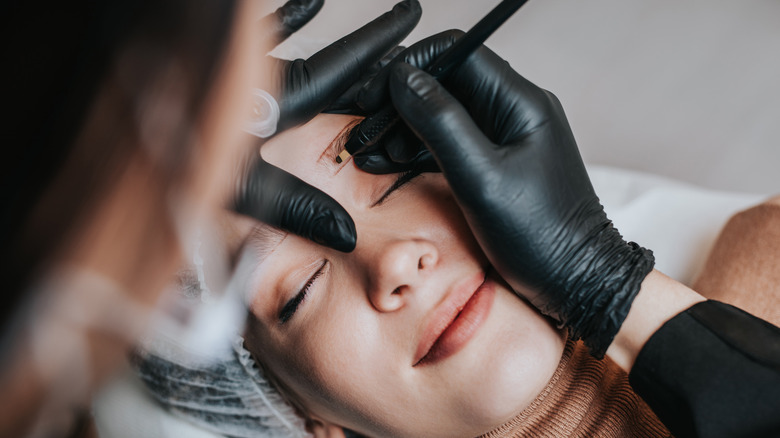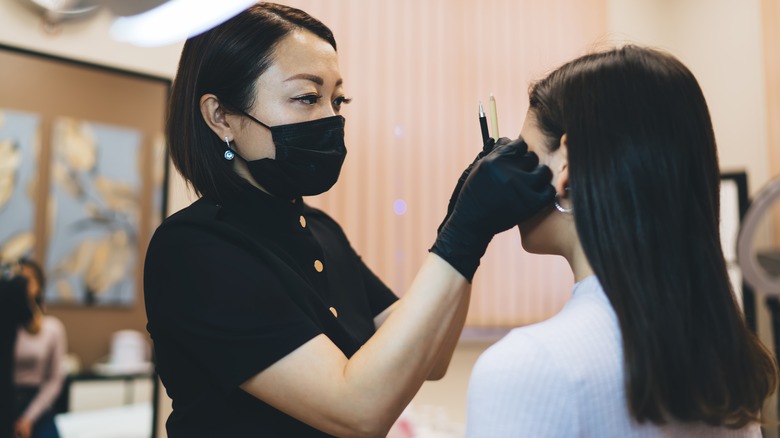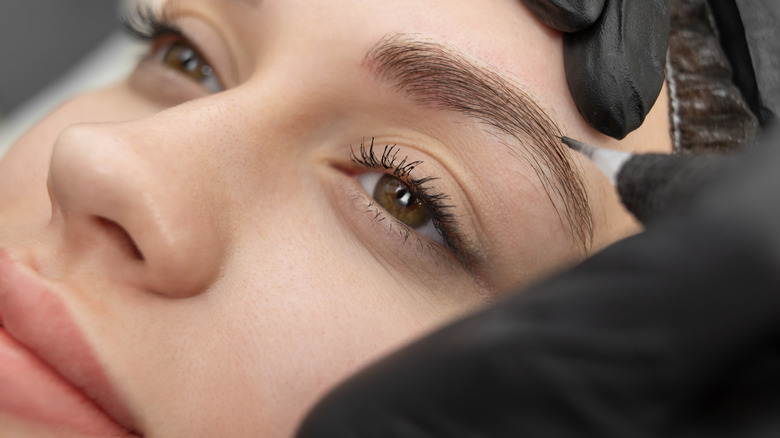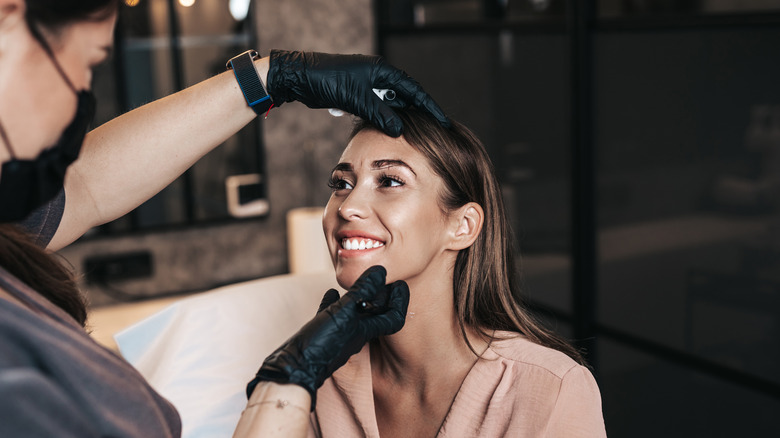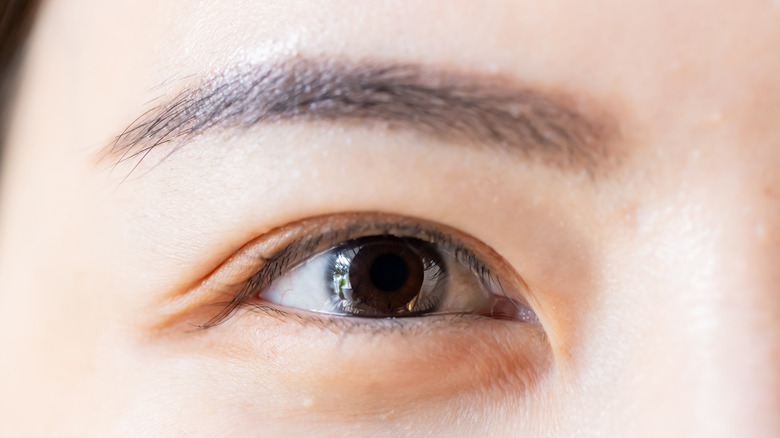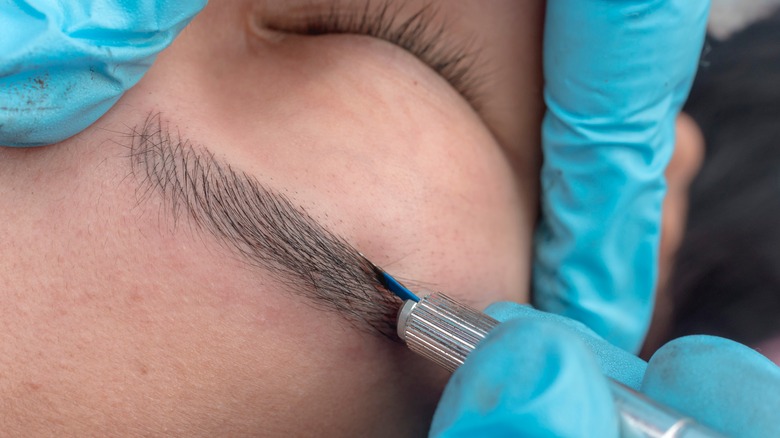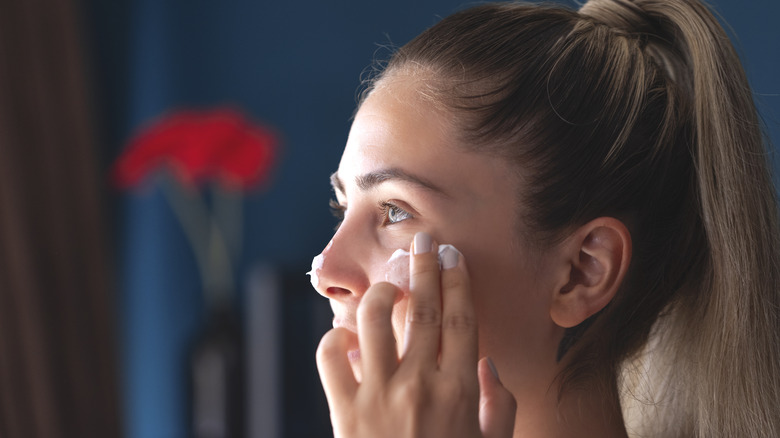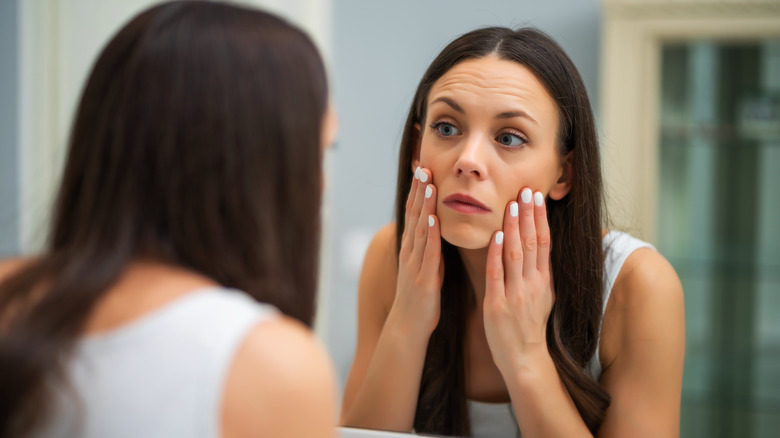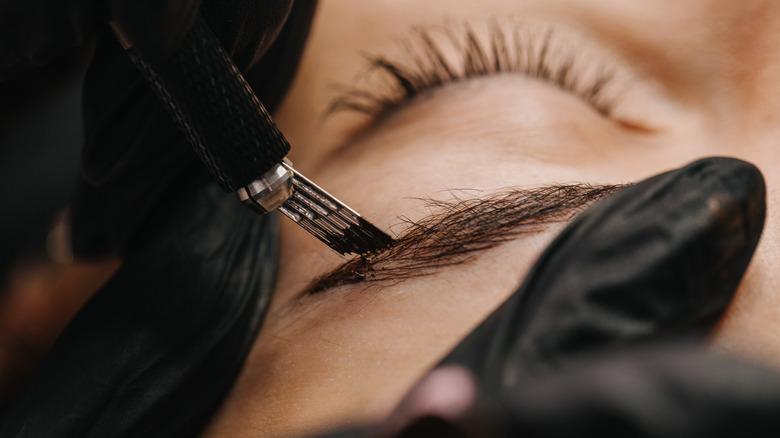Microfeathering Is The More Natural Alternative To Microblading
While microblading is a great solution for thin brows, this semi-permanent makeup may not be suitable for everyone, especially those who already have a decent amount of brow hair to work with, according to Hairy Little Things. Thankfully, the beauty gods are generous and wise, as there is a new technique called microfeathering that's quickly becoming a favorite alternative.
Eyebrows have become an important part of the everyday beauty routine, with popular trends emphasizing thick and feathered brows. This look is certainly an improvement for people with naturally thick brows, but not so much for those with sparse or nonexistent brows. And unless the new year brings a revival of the thin brows from the '90s and early 2000s, it seems that the full-eyebrow look is here to stay.
While brow pencils can help transform thin or sparse eyebrows, microfeathering is a more efficient and lasting method for maintaining that trendy, thick look. But what exactly is it, and what makes it different from microblading? Here's what you need to know to decide if microfeathering is a better option for you.
What is microblading?
According to Microblading L.A., microblading became popular around 2015 when beauty trends began to stray from pencil-thin brows and veer toward thickly arched brows. While brow pencils are life-saving beauty tools and certainly get the job done, the time and precision it requires to draw on your eyebrows can quickly become tiresome. Understandably, this is why microblading has remained so popular since its initial uptick back in 2015.
So, how does microblading work? The actual microblading procedure involves the use of a tattoo machine to implant ink underneath the skin, per Candid Cosmetics. An esthetician will use a tattoo pen with a thin needle to manually create thin strokes and mimic the appearance of individual hairs. This form of semi-permanent makeup is perfect for filling in severely thin brows, whether that be from over-plucking or genetics. Microblading typically requires several sessions until the desired look is achieved, after which the ink can last anywhere from one to three years.
What is microfeathering?
Similar to microblading, microfeathering is also a form of semi-permanent makeup. Both microblading and microfeathering require the use of a thin tattoo needle, though the size of the needle will vary depending on several factors such as your esthetician, the thickness of your natural eyebrow hairs, and your desired look (via Acacia B. Brows & Beauty). For microfeathering, however, an esthetician uses light, feathery strokes with the tattoo needle. This specific technique also tends to focus on certain areas of your brows, as opposed to tattooing all over, per Lita Brows.
The main appeal for microfeathering lies in the ability to create brows that appear natural yet full by filling in the gaps in your natural brows. Microfeathering, therefore, aims to make your brows appear full enough for you to rock a natural eyebrow look whenever you want to ditch the brow pencil (via Lita Brows). A subtle look is key for this technique, especially since the focus is on lightly filling in sparse areas.
Is microfeathering right for you?
Both microblading and microfeathering are game-changing beauty innovations that are designed to boost your confidence and make your life a whole lot easier. So, which one should you choose? There are two key differences between the two that should be considered before you make your appointment.
The most important distinction between microblading and microfeathering lies in the application technique, as they both create a vastly different look. For instance, microblading can help you achieve fullness so you can wake up with perfectly-shaped brows that, generally, don't require any touch-ups (via Lita Brows). However, if you prefer natural-looking brows that you can either leave as is or fill in depending on your desired makeup look, then microfeathering is your best bet. Microfeathering is perfect for people who prefer to sport simple makeup looks that emphasize light, feathery brows.
Another important factor to consider is the shape and thickness of your eyebrows. If you currently have thin eyebrows that lack definition or shape, then microblading will be the best option. On the other hand, if you already have a fair amount of eyebrow hair, or you simply want to fill in certain gaps to enhance your natural brows, then microfeathering is a better option for you, per Hairy Little Things. If you're still unsure which technique is right for you, remember that beauty trends are fickle. Microblading and microfeathering are semi-permanent beauty treatments, so regardless of which technique you choose, you're not stuck with one look forever.
How to prepare for your microfeathering appointment
Preparing for your microfeathering appointment is essential to achieve the best possible results. First and foremost, you need to allow your eyebrows to regrow naturally in the weeks leading up to your session. "I insist on working with one's natural brow shape and not a previously shaped brow," Kristie Streicher, co-founder of Striiike Salon, advised Byrdie. "Not working with the individual's natural hair growth pattern can detrimentally affect the outcome. My greatest fear is to take away the very thing that gives us a beautiful natural brow and individual character."
In addition to letting your brows grow, you also need to focus on your overall health. PMUHub advises abstaining from caffeine and alcohol for a minimum of 24 hours prior to your appointment. Also, if you are taking any blood thinners, such as aspirin, you should stop a week prior to your session to minimize the risk of bleeding during the microfeathering process. However, bear in mind that you should always speak to your doctor first before halting any medications. Finally, to ensure optimal results, plan your microfeathering appointment well in advance of other beauty treatments — this means no facials or facial injections for at least two to four weeks before the procedure.
What the microfeathering procedure is like
A microfeathering procedure is a multi-step journey that begins with a crucial consultation. During this initial phase, you will be guided through the entire process, gaining a clear understanding of what you can expect. Since microfeathering is a very individual procedure, not everyone will have the same experience, as not everyone needs the same areas of their eyebrows filled. The process is similar to microblading in that there are small incisions made to mimic hair. "Pigment is then deposited into the incisions, resulting in an incredible natural-looking 'eyebrow hair,'" Kristie Streicher revealed to Glamour.
Microfeathering usually consists of two procedures, each happening in a separate session. Streicher explained that the first appointment is something like a test. "During the first appointment, microfeathered strokes are created in some of the more dense areas of the brow," she continued. "Six to eight weeks later, depending on how your skin heals and responds, additional strokes are then added."
Microfeathering aftercare
Proper aftercare is vital for your microfeathering treatment. If you don't take care of your brows following your appointments, you probably won't be impressed with the result. In the initial days after the procedure, you'll need to gently remove built-up lymph using a clean cloth, according to PMUHub. Lymph is a light-colored fluid that leaks when your skin is cut or cracked, and in order to prevent infection, the area around the wound needs to be cleaned (via Lymphoedema Education Solutions).
After this phase, it's essential to establish a regular brow care routine, cleaning them once or twice daily and applying any prescribed aftercare ointment. During the first two weeks, you should also refrain from wearing brow makeup and avoid activities that lead to excessive sweating. Additionally, you need to exercise caution with certain skincare products. "Be careful using products such as retinol and glycolic acid [which can be harsh on skin and lift away pigment] near the brow area," brow expert Samantha Trace shared with Refinery29.
Sun protection is also crucial during the healing process. "SPF is very important for the brows. It's encouraged to wear SPF on your face every day anyway, but getting it under the brow hairs and into the skin will prevent premature fading [of the pigment]," the founder of Pretty in The City Lash and Brow Bar, Veronica Tran, told 29 Secrets. Once your brows have healed, you can book a touch-up session.
Possible side effects of microfeathering
Like any beauty treatment, microfeathering is not without potential side effects. It's crucial to be aware of these possibilities so that you can make an informed decision. After the procedure, it's common to experience some initial swelling, redness, and discomfort in the treated area. After a few days, a dark scab will form, and it will eventually fall off, revealing a lighter pigment underneath. Over the next couple of weeks, this pigment will gradually darken, resulting in the desired look (via PMUHub).
However, individual skin types can influence how microfeathering heals. For those with oily skin, the constant production of oil may lead to the hair strokes healing with a thicker appearance. "Overall, the pigment may get rejected by oils in the skin, or the result will appear fuzzy, requiring frequent touch-ups," Kristie Streicher commented to Byrdie. Individuals with sensitive skin who often experience conditions like rosacea or eczema should also be aware of possible complications. "Generally, this skin type bleeds very easily and has a harder time healing, which causes the pigment to appear more ashy, blurred, and patchy," Streicher added.
To avoid side effects as much as possible, it's important not to get a microfeathering procedure done on a whim. "Clients really need to do their research and choose an artist that is tried, tested, and trusted. This should be someone that is a specialist in their field," the founder of Tracie Giles Permanent Makeup & Aesthetics told Refinery29.
Cost and longevity of microfeathering
The investment and durability of microfeathering are essential factors to consider when deciding whether this beauty treatment is for you. Prices for microfeathering can vary depending on the artist and location. For instance, with Kristie Streicher, the microfeathering process, which consists of two appointments, costs $2,500. However, it is possible to get it done for less — at Bend Brows and Beauty, the two appointments cost $650.
On average, feather eyebrows typically last around 18 months (per PMUHub); however, this varies from person to person. "An annual color boost is advised to keep the brows crisp," Samantha Trace said to Refinery29. She added that since the color isn't applied deeply into the skin, microfeathering tends to fade quicker than microblading. "As a result, the pigment simply fades away, which makes it a better treatment for someone who may wish to change the style in a few years." Still, while you can master the fluffy brow trend with makeup, microfeathering remains a great option for anyone looking to save some time by waking up with stunning eyebrows every day.
